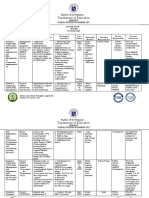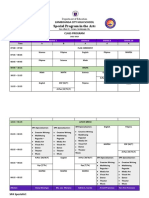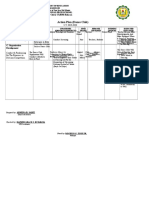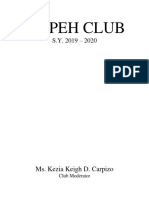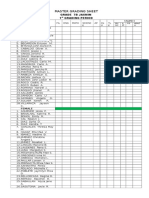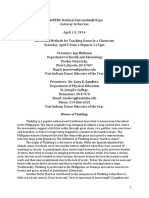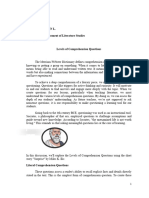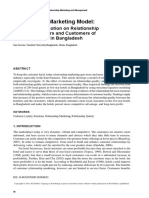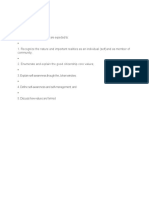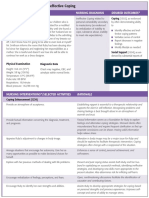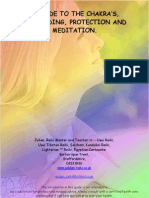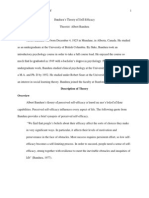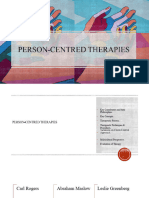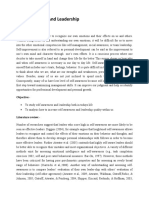Professional Documents
Culture Documents
Special Program in The Arts (Spa) I. Vision and Mission A. Vision
Special Program in The Arts (Spa) I. Vision and Mission A. Vision
Uploaded by
Rogerson PenaOriginal Description:
Original Title
Copyright
Available Formats
Share this document
Did you find this document useful?
Is this content inappropriate?
Report this DocumentCopyright:
Available Formats
Special Program in The Arts (Spa) I. Vision and Mission A. Vision
Special Program in The Arts (Spa) I. Vision and Mission A. Vision
Uploaded by
Rogerson PenaCopyright:
Available Formats
SPECIAL PROGRAM IN THE ARTS (SPA)
I. Vision and Mission
a. Vision
We envision holistically developed and excellent young artists
through a learner-centered curriculum committed to the promotion of
Filipino culture and heritage preservation.
b. Mission
To provide avenues where students with potential in any field of arts
can progressively enhance their talents and skills towards the promotion of
Filipino culture, heritage preservation and the development of global
excellence.
II. Objectives
1. Develop knowledge and skills of students with potential in the Arts: Music, Visual
Arts, Theater Arts, Media Arts, Creative Writing, Dance, and/or Traditional Arts.
2. Stimulate learners’ creativity and sense of imagination.
3. Hone the learners’ various facilities of expression to communicate their ideas and
feelings through their chosen art forms.
4. Foster a sense of pride of being a Filipino through appreciation of culture and arts.
5. Cultivate aesthetic awareness and identity.
III. Description of the program
The Special Program in the Arts is a program for learners with potentials
or talents in the arts namely, Music, Dance, Theatre Arts, Visual Arts, Media Arts,
and Creative Writing.
The program offers a comprehensive basic education centered on the
arts, covering a range of art forms and disciplines. Arts education is an integral
component of a balanced educational program, which aims to prepare graduates
for the world of work or for higher education.
The program was piloted in 2000–2004 in fifteen (15) junior high
schools, one (1) from each region. After the pilot implementation, these schools
were transformed into lead schools and later institutionalized. As lead schools,
Version 3 as of May 11, 2018
they shall encourage other schools to implement the program. This program has
been adopted by other public and private high schools throughout the country.
The latest expansion of the SPA is the Senior High School career pathway,
named Arts and Design Track which gives the learners the opportunities for work
immersion and community involvement through the arts.
The program aims to lead the learners to different careers in the Creative
Industries such as:
MUSIC
1. Sound Effects Editor 9. Events Performer
2. Casting Agent 10. Disc Jockey
3. Talent Agent 11. Amateur/Professional Singer
4. Voice Actor 12. Music Composer
5. Music Teacher 13. Amateur/Professional
6. Music Professor Musician
7. Music Therapist 14. Sound Designer
8. Opera Singer
MEDIA ARTS
1. Multimedia Designer 15. Logo Designer
2. Product Designer 16. Layout Artist
3. Web Developer 17. Book Illustrator
4. Video Game Director 18. Teacher
5. Print Designer 19. Journalist
6. Game Level Designer 20. Professor
7. Motion Graphics Design 21. Film Director
8. 3D Modeling 22. Cinematographer
9. Medical Illustrator 23. Photographer (macro,
10. Graphic Designer wedding, aerial, celebrity,
11. Website Designer advertising, wildlife,
12. Interior Designer underwater, sports, nature)
13. Automobile Designer 24. Storyboard Artist
14. Film Editor 25. Comic Book Artist
Version 3 as of May 11, 2018
DANCE
1. Amateur/Professional Dancer
2. Dance Director
3. Choreographer
4. Dance Teacher
5. Dance Professor
6. Dance Researcher
7. Athlete
THEATRE ARTS
1. Set Designer
2. Teacher
3. Journalist
4. Professor
5. Theater Director (Lights, Stage, etc.)
6. Film Director
7. Stand-up Comedian
8. Amateur/Professional Actor
9. Make-up Artist
10. Costume Designer
11. Stage Manager
CREATIVE WRITING
1. Novelist
2. Screenwriter
3. Playwriter
4. Calligraphist
5. Teacher
6. Journalist
7. Professor
8. Researcher
9. Segment Producer
10. Influencer
Version 3 as of May 11, 2018
VISUAL ARTS
1. Visual Effects Animator 33. Professor
2. Video Game Designer 34. Fashion Merchandiser
3. Computer Animator 35. Fashion Model
4. 3D Animator 36. Fashion Designer
5. Comic Book Artist 37. Dressmaker
6. Cartooning Artist 38. Tailor
7. Architect 39. Home-stager
8. Naval Architect 40. Fashion Consultant
9. Landscape Architect 41. Pattern Making Designer
10. Industrial Design 42. Make-up Artist
11. UI/UX Artist 43. Costume Designer
12. Transportation Designer 44. Pastry Chef
13. Accessory Designer 45. Food styler
14. Jewelry Designer 46. Cake Decorator
15. Tattoo Artist 47. Ice Sculptor
16. Muralist 48. Wood Sculptor
17. Museum Exhibit Designer 49. Mosaic Artist
18. Museum Curator 50. Taxidermist
19. Screen Printer 51. Ceramics Artist
20. Shoe Designer 52. Craft Artist
21. Urban Designer 53. Found Art Collector
22. Textile Designer 54. Blacksmith
23. Art Historian 55. Glass Blower
24. Art Auctioneer 56. Sculptor
25. Book Illustrator 57. Portrait Artist
26. Toy Designer 58. Art Dealer
27. Floral Designer 59. Air Brushing Artist
28. Furniture Designer 60. Graffiti Artist
29. Swimming Pool Designer 61. Painter
30. Golf Course Designer 62. Storyboard Artist
31. Teacher 63. Courtroom Sketcher
32. Journalist 64. Caricaturist
Another arm of the program is the inclusion of Elementary levels, Interest
Clubs for non-SPA schools, Special Education Program for the Gifted, and
Alternative Learning System. Regional Arts Academies will also be established in
order to raise the bar a notch higher compared to the current status of the SPA
schools.
Version 3 as of May 11, 2018
A. Curriculum and Instruction
1. Curriculum Design
The Grades One to Three curriculum covers an integrated arts approach to
the understanding and appreciation of the Arts. The content will also cover an
appreciation of local culture, heritage, and expression of the arts.
This is designed for the learner to express ideas about the environment in an
atmosphere of creativity, fun and play through the use of the body, space, sound,
images, and stories.
The Grades Four to Five curriculum shall introduce the learners to the
different art specializations, namely, Music, Dance, Theatre Arts, Creative Writing,
Visual, and Media Arts.
Music focuses on how learners use their voices and or their bodies often in
relation to other objects to convey artistic expression. The performers will focus on
different emotions. Music facilitates the learners’ exploration of their various
soundscapes and the discovery of their own media, both vocal and instrumental
applying the foundations in music.
Dance develops the learners’ awareness of the human body as medium of
self-expression, artistic expression, and non-verbal communication.
Theatre Arts focuses on the spontaneous expression of emotions and feelings
through role playing, acting, strengthening the Theatre Artistic elements of music
and dance performance.
In Visual Arts, Media Arts, and Creative Writing, the curriculum is designed to
enable and facilitate the exploration and expression of stories and narrative is
through the use of non-performative art forms such as texts, visuals (2D 3D), and
media. The learners will be exposed to the use of both textual and non-textual
metaphors to communicate ideas and emotions.
The Grades Six to Ten curriculum provides intensive training on the six art
specializations:
a. Music
The Music specialization is designed for the continued exploration of voice
and instrument. Learners will understand and appreciate music by using knowledge
of music theory, history, and the connections to the culture it was produced.
Version 3 as of May 11, 2018
Learners will be able to demonstrate a progressive mastery of musical skills and
concepts.
b. Dance
The Dance specialization focuses on the learners’ movement vocabulary,
development of technique and deeper understanding of dance as an art form using
the body as a medium of expression.
c. Theatre Arts
The Creative Theatre Arts specialization is an improvisational and process
oriented form of creation where the students will explore creative theater
techniques appropriate to their developmental level to produce or mount situations
with real or imagined characters using dialogues, sceneries, scenarios and other
forms of storytelling.
d. Visual Arts
The Visual Arts specialization focuses on an in-depth exploration of the basic
elements (lines, shapes, textures, forms, pattern and color) through the
development of visual consciousness in terms of its relationship to the environment
which gives meaning to the art-maker and the viewer.
e. Creative Writing
The Creative Writing specialization is designed to bring out the young
writer’s imagination, emotions and ideas through writing of different forms of
literature such as poetry, essays, storytelling, scripts, diaries, memoirs, blogs, lyrics,
or free writing.
f. Media Arts
The Media Arts specialization, is centered on the use of a medium through
which the learner may transfer, communicate, or express their interpretation and
understanding of their environment. The curriculum is designed so that the learner
will be introduced to the concepts and principles of communication and expression
through media and media tools.
Version 3 as of May 11, 2018
Edukasyong Pangkabuhayan at Pangtahanan (EPP) or Technology and
Livelihood Education (TLE) competencies shall be contextualized according to the
needed lifelong-learning skills in their respective art specializations.
The SPA teacher shall be tasked to teach following EPP/TLE competencies
according to the Art specialization:
1. Visual Arts, Media Arts and Drama: Woodworks/carpentry incorporated in
wooden sculptures, furniture design, stage design
2. Creative Writing, Visual Arts, Media Arts, Music, and Drama: ICT – animation,
music compositions, music production, stage design
3. Music, Dance, and Drama: Housekeeping – costume care and set management
4. Music, Dance, and Drama: Sewing – costume design and development
5. Music, Dance, Drama, and Visual Arts: Cosmetology – hair and make-up
needed for performances
Common competencies for all Art Specializations:
1. Personality development – proper hygiene and social graces
2. Customer relations
3. Cookery – cooking their own food during rehearsals, productions, or
competitions
4. Entrepreneurship – producing, promoting, and marketing own performances
and exhibits
Meanwhile, Edukasyon sa Pagpapakatao (EsP) or Values Education
competencies shall also be integrated into the SPA curriculum.
2. Program requirements
a. Program Standards
i. Music
The SPA music curriculum focuses on four threads which at the end of the
program will equip the learner as an engaged artist in the field of music:
● music as borne of the expression of the self as seen in the Filipino tales, epics,
rituals, and festivals;
● music as a community resource rooted in the natural, tangible, and intangible
heritage of the people;
● music as an continuing expression of the people’s history; and
Version 3 as of May 11, 2018
● music as a contextualized reality from the local to global perspectives in the
contemporary times.
Along with four threads, the curriculum will develop the learner‘s
knowledge, appreciation, and skills in music using the seven building blocks of
music distributed across the curriculum (Philosophy of Music; Overview of Music;
Music Elements and Concepts; Music Processes and Skills; Musical Instruments;
Music Genre and Styles; People of Music). The SPA program is a spiraling program,
grounded on performance-based learning. At the end of the program the learners
will have gained the basic and intermediate skills in music which will prepare them
for a career and/or higher education in music and other art disciplines.
i.i. Dance
The SPA dance education curriculum recognizes that all students have the
right to an arts education as a fundamental part of basic education. This dance
curriculum enables students to discover their own innate capacity for
communication of ideas, thoughts, and feelings through the medium of dance. The
dance curriculum will cover dance history, creative work and processes, dance
forms and techniques, performance and production, aesthetics, meaning and
significance of movements to the Philippine communities and the foreign influences
to the Philippine dances, techniques and movements.
All of the art forms provide ways in which people can bring shape and order
to the fragmented and rapidly changing world. Dance provides a primary medium
for expression involving the total self. A person's self-concept, one’s own identity
and self-esteem are improved through the use of body movements. Perceptions,
thoughts, and emotions are grounded in a physical experience through dance. As a
participatory experience, dance nurtures and fosters a sense of respect to cultural
diversity. The value of group work and cooperation is inherent and reinforced.
The dance curriculum focuses on the holistic development of the students
providing them with exploration, selection, organization, and evaluation
experiences. These experiences include appreciation of cultural and social heritage,
exploration of values and ideas, movement skills development and refinement,
sensory integration, originality in movement, creative approach to learning,
performance, expression, critical and creative thinking, aesthetic cognition, and
development of self-esteem, respect for others, self-discipline and other life skills.
i.i.i. Theatre Arts
Version 3 as of May 11, 2018
The Creative Theatre Arts curriculum will harness the potentials of the
theater and Theatre Arts as a medium for the expression of the soul, cultivation of
cultural identity, creating an impetus for other artistic activities, promotion of a
personality to self-realization, an anchor for historical and cultural understanding,
for transformational values, and promotion of human rights.
The learner is envisioned to immerse in an educationally liberating process
that will provide him a creative anchor of inestimable value for developing a
distinguished profession grounded in the various sub-disciplines of the theatrical
art. Whether they turns out to become an actor, director, playwright, choreographer,
composer, lights and sound technician, manager or teacher in the Theatre Artistic
profession, they shall be properly tooled to steer themselves to an empowered
future.
The intensive training in theater shall lay the foundation for developing the
consciousness, knowledge, skill, and attitudes of the growing theater artist to a life
steeped in an appreciation of heritage, charged with skills for artistic excellence, and
stimulated with a spirit for fermenting sustainable development of self, community,
and the nation
i.i.i.i. Visual Arts
The Visual Arts Curriculum recognizes that all learners have the right to an
Art Education as a fundamental part of basic education. This enables learners to
discover their own innate capacity for communication of ideas, thoughts, and
feelings through Visual Arts.
The Curriculum will cover art history, creative work and processes, art forms
and techniques, production, aesthetics, meaning and significance of visual arts to the
Philippine communities and foreign influences to the Philippine visual art.
It also provides students with discovery, selection, organization, and
evaluation experiences that includes appreciation of cultural and social heritage,
exploration of values and ideas, skills development and refinement, sensory
integration, originality in design, creative approach to learning, performance,
expression, critical and creative thinking, aesthetic cognition, and development of
self esteem, respect for others, self-discipline and other life skills.
i.i.i.i.i. Creative Writing
The SPA Creative Writing Curriculum will harness the learner in self-
Version 3 as of May 11, 2018
expression, cultural identity, and promotion of a personality to self-realization, an
anchor for historical and cultural understanding, for transformational values, and
promotion of human rights.
The learner is envisioned to immerse in an educationally liberating process
that will provide him a creative anchor of inestimable value for developing a
distinguished profession grounded in the various forms of literature such as poetry,
narratives, stories, essays, or scripts.
The intensive training in creative writing shall lay the foundation for
developing the consciousness, knowledge, skill, and attitudes of the learner with an
appreciation of heritage, commitment to excellence for sustainable development of
self, community, and the nation.
i.i.i.i.i.i. Media Arts
Media Arts under the Special Program in the Arts is the study of human
communication through photography, broadcasting, print media, online media,
videography and film. In this art form, students are trained to use the elements of
space, time, light, motion, color and sound to express their perspectives, feelings and
ideas creatively. Likewise, students are taught to appreciate the values of cultural
identity and inculcate or include these themes for a more significant and high sense
of identity. Critically, they learn to interpret and evaluate media within aesthetic,
cultural and historical contexts to become more enlightened consumers, critical
individuals and effective citizens.
The learners are taught creative use of communications technologies to tell
stories and explore concepts for diverse purposes and audiences. Media artists
represent personal, social and cultural realities using platforms such as television,
film, video, newspapers, magazines, radio, and the worldwide web. Media Arts
explores the diverse artistic, creative, social and institutional factors that shape
communication and contribute to the formation of identities. The Learners
participate in, experiment with and interpret the rich culture and communication
practices surrounding them.
Version 3 as of May 11, 2018
b. Learning Standards
i. Music
Grade 7 Grade 8 Grade 9 Grade 10
The learner demonstrates an appreciation and understanding of the concepts and
principles of Music, Aesthetics, and History within the context of Philippine cultural
and historical realities. The course ends with musical performances imbued with
artistic creativity, sense of community, and pride of place. Each performance
incorporates sensitive interaction with Filipino indigenous heritage, values of human
and social development, and mobilizing skills for a career in the arts.
i.i. Dance
Grade 7 Grade 8 Grade 9 Grade 10
The learner demonstrates understanding of the concepts and principles of dance, dance
aesthetics, history, choreography and dance performance within the cultural and
historical context of Philippines, Asian and the World as a whole and master the
application of these concepts and principles, resulting in the development of dance artists
and dance works imbued with creativity, sense of community and pride of place, with due
recognition and inspiration from the indigenous traditions, equipped with knowledge
and skills for career in dance and its contribution to social development.
Version 3 as of May 11, 2018
i.i.i. Theatre Arts
Grade 7 Grade 8 Grade 9 Grade 10
The learner The learner The learner The learner
demonstrates demonstrates demonstrates demonstrates
appreciation and understanding of understanding of understanding of
understanding of the basic concepts, the basic concepts, the basic concepts
the basic language of principles, and skills principles, skills of and principles of
the creative arts, of THEATER THEATER relevant THEATER
focusing on theater relevant to creating to creating interacting with
arts as an seminal works on processes and other disciplines
INTEGRATED Community Realities works reflecting relevant to the
LANGUAGE of and Life Sources for History and Heritage creation of major
personal, group, and the awareness and for the exploration works reflecting
cultural expression exploration of of creativity, sense Contemporary
and creativity in creativity, sense of of self and cultural Realities for the
stories, ritual, myth, self and cultural identity, and social proficiency in
and cultural identity, and social responsibility. artistic creativity,
enactments for the responsibility leading to a sense of
release of creativity, self, cultural
and awareness of identity, and social
self and cultural responsibility.
identity, and sense
of social
responsibility.
i.i.i.i. Visual Arts
Grade 7 Grade 8 Grade 9 Grade 10
The learner demonstrates understanding of the concepts and principles of Visual Art, art
aesthetics, history, tradition, production and performance within the cultural and
historical context of Philippines, Asian and the World as a whole and master the
application of these concepts and principles, resulting in the development of Visual
artists and art works imbued with creativity, sense of community and pride of place, with
due recognition an
i.i.i.i.i. Medial Arts
Version 3 as of May 11, 2018
Grade 7 Grade 8 Grade 9 Grade 10
The learner The learner The learner The learner
demonstrates an demonstrates an demonstrates an demonstrates an
understanding of understanding of understanding of understanding of
the basic concepts the basic concepts the basic concepts the basic concepts
and principles of and principles of and principles of and principles of
visual media and photography and journalism and its film and cinema
communication online media manifestations in through active
through active through active print, radio, participation in
participation in participation in television, and creative projects
creative projects creative projects online mediums and artistic
and artistic and artistic through active endeavors for self-
endeavors for self- endeavors for self- participation in development, the
development, the development, the creative projects development of
development of development of and artistic aesthetic potential,
aesthetic potential, aesthetic potential, endeavors for self- the promotion of
the promotion of the promotion of development, the cultural identity, and
cultural identity, and cultural identity, and development of the expansion of
the expansion of the expansion of aesthetic potential, one’s world vision.
one’s world vision. one’s world vision. the promotion of
cultural identity, and
the expansion of
one’s world vision.
i.i.i.i.i.i. Creative Writing
Grade 7 Grade 8 Grade 9 Grade 10
The learner demonstrates an appreciation and understanding of the concepts and
principles of Creative Writing, Aesthetics and History within the context of Philippine
cultural and historical realities. The course ends with the literary works imbued with
artistic creativity, sense of community and pride of place. Each literary work incorporates
sensitive interaction with Filipino indigenous heritage, values of human and social
development, and mobilizing skills for a career in the arts.
c. Time Allotment
Version 3 as of May 11, 2018
For Grades 1 to 6 the Special Program in the Arts shall be offered on a 200-minute
weekly time frame, 50 minutes per day, 4 times a week.
For Grades 7 to 10, the Special Program in the Arts shall be offered on a 400-minute
weekly time frame or two (2) hours per day, four (4) times a week.
Curriculum Offerings on SPA Elementary with Learning Areas
LEARNING Grade Level
AREA
1 1 2 3 4 5 6
1st Sem 2nd Sem
No. of Minutes Daily
Mother Tongue 50 50 50 50 - - -
Filipino 30 30 50 50 50 50 50
English - 30 50 50 50 50 50
Science - - - 50 50 50 50
Math 50 50 50 50 50 50 50
Araling 40 40 40 40 40 40 40
Panlipunan
Contextualized - - - - 50 50 50
EPP/TLE
MAPEH 40 40 40 40 40 40 40
EsP 30 30 30 30 30 30 30
Special Program 50 mins/ 50 mins/ 4x 50 50 50 50 50
in the Arts 4x a week a week mins/ mins/4 mins/ mins/ mins
4x a xa 4x a 4x a /4x a
week week week week week
TOTAL Hrs/day 4.8 5.3 6 6.8 6.8 6.8 6.8
Curriculum Offerings on SPA with Subjects for Junior High School
Version 3 as of May 11, 2018
Grade Level
LEARNING AREA
7 8 9 10
Hour/Week Hour/Week Hour/Week Hour/Week
English 4 4 4 4
Science 4 4 4 4
Math 4 4 4 4
Filipino 4 4 4 4
Araling Panlipunan 3 3 3 3
MAPEH 4 4 4 4
Contextualized TLE for SPA 2 2 2 2
Special Program in the Arts 8 8 8 8
(w/ EsP Competencies)
Revitalized Homeroom 1 1 1 1
Guidance Program
Civilian Training Program 2 2
(CTP)
TOTAL No. of Hours per Day 7.2 Hrs 7.2Hrs 7.6 Hrs 7.6 Hrs
d. Medium of Instruction
The medium of instruction for the Special Program in the Arts is generally in English
and Filipino. However, in Grades 1-3, the use of Mother Tongue is highly encouraged
especially in the Creative Writing classes.
e. Class Size
The school that offers the Special Program in the Arts may have a maximum
of 30-40 students per class.
Version 3 as of May 11, 2018
3. Eligibility
a. Screening and Admission
This section defines the criteria in the selection, and guidelines in the admission of
learners. The administration of tools (e.g. High School Occupation and Interest Inventory
(HSOII), Multiple Intelligence (MI) Based Assessment, Physical Fitness-Sports Talent
Identification and Skills Tests, SPJ Qualifying Examination, SPA Artistic Encounter Test, and
Individualized Education Program) for screening of learners based on interest and
aptitude. The interpretation and utilization of results serve as basis in the admission of the
learners in the program.
i. Screening
The school shall organize a special program committee composed of: SIP
Coordinator, SIP teacher/s, and Guidance Counsellor/Designated Guidance
Counsellor, to perform the following functions:
Stage 1: Preliminary selection through documentary evaluation to assess
the readiness /qualification of applicants based on the basic
requirements as follows:
1. NSO Birth Certificate
2. Certificate of good moral character
3. Medical Certification
4. Form 138-A for 1st and 2nd quarter of the previous grade level
5. Referrals and other relevant certifications
Stage 2: Administering the school’s General Admission Test by the school’s
Guidance Counsellor.
Stage 3: Administration of audition according to art specialization under
the supervision of the SPA Coordinator and Art Specialization
Teachers.
Stage 4: Artistic encounter test and Interview of the applicant, together
with the parent/ guardian to validate the documents submitted
and to gauge the possibility of the applicant to succeed in the
program.
Version 3 as of May 11, 2018
ii. Admission
Applicants who passed the screening process shall be admitted in the
Special Curricular Program on the following merits:
School’s General Admission Test - 20%
Audition - 20%
Artistic Encounter - 40%
Interview - 20%
---------------
TOTAL - 100%
Learners will be admitted in the Special Program in the Arts provided
the student and the parents conform to the following conditions as stipulated
in the duly notarized Admission Contract:
a. Grade requirements
b. Attendance in Rehearsals, Performances or Production sanctioned
by the school/division/region
c. The school shall NOT be held liable for rehearsals, performances or
production NOT sanctioned by the school/division/region.
d. Student’s proper conduct and behavior
e. Parent’s moral, emotional, psychological and financial support
relative to the program.
Other requirements or screening tools specific to special curriculum
program are appended.
b. Assessment and Grading System
i. Selection of Honors and Special Awards
There shall be a pre- and post-performance profile of every
student per specialization every school year.
To qualify for honors, candidates should be able to meet the
criteria prescribed by DepEd in conformity with the latest policies and
guidelines pertaining to honor students.
Version 3 as of May 11, 2018
ii. Special Achievement Test (not applicable)
iii. Promotion, Retention, and Transfer
Promotion
Promotion of the students shall follow DepEd Order 8, s. 2015 and DepEd
Order 29, s. 2015, unless otherwise rescinded.
Retention
A learner shall be retained in the program if he/she:
● maintains an average grade of 83% in all academic subjects and 85% in
his specialization subjects to be retained in the program.
● Maintains a General average of 83% to be retained in the program.
● For students who are at risk of receiving grades lower than 80, learning
managers may choose from the following:
- (Option A) He/She is advised to attend remedial classes to comply
with the grade requirements.
- (Option B) He/She shall be given relevant extra work to comply with
the subject’s grade requirements.
Transfer
A student transferring to the SPA from another program needs to undergo
the same process of student admission. The student is required to take at
least 30 hours of summer training and/or workshops of the specializations
he/she has not taken. The Division Office must be advised of the SPA summer
classes to be conducted. Transfer shall only be allowed until grade 8.
B. LEARNING ENVIRONMENT AND RESOURCES
This article serves as the governing principles and guidelines of all Special
Program in the Arts under this component.
Version 3 as of May 11, 2018
1. Facilities and Equipment Requirement
a. Physical Facilities
i. Instructional Spaces/ Classrooms
Schools that offer the Special Program for the Arts must have
adequate instructional rooms that conform to the minimum standard for
instructional spaces as stipulated in the Manual of Educational Facilities.
These instructional spaces include classrooms, computer rooms, arts studios
and/or laboratories.
On top of these basic facilities, implementing schools must have other
needed facilities to ensure successful delivery of the special curricular
programs.
The general facility requirements are:
● 2 music studios (1 for vocal music and 1 for instrumental
music)
● dance studio
● theater laboratory
● visual arts studio
● creative writing classroom
● media arts studio
● Library
b. Tools and/or Equipment
Special Curricular Programs require specific tools, equipment, and
assistive devices necessary to support the program implementation.
NOTE: See Appendix on Technical-Specifications for Facilities, Tools, and
Equipment for Special Program in the Arts and SHS Arts & Design Track
Version 3 as of May 11, 2018
2. Instructional and Learning Resources
a. Learning Materials
Provision for sufficient and various learning materials designed to
meet the specific needs of the diverse learners should be made available:
1.1 Print
Refers to printed materials such as textbooks, modules, handouts,
brochures and other materials that come in hard copies.
1.2 Non-Print
Include materials in soft copies such as CDs, software programs and
other resources found in the Internet.
b. Teacher Resource Materials
Utilization of a wide array of print and non-print resource materials
by the teachers to address the various needs of diverse learners is highly
encouraged.
NOTE: See Appendix on Technical-Specifications for Facilities, Tools, and Equipment for
Special Program in the Arts and SHS Arts & Design Track
C. LEADERSHIP AND GOVERNANCE
Special Curricular Program Qualification Standards shall be a component of all
school-based, community-based, home-based and other services. These shall be
coordinated with medical, social, physical, intellectual, artistic & creative, innovative,
scientific and technical -vocational services.
All academe, health, welfare and other community services, like parent-teacher
association, civic social organizations, and other groups that can help enhance the skills of
the learners in the Special Curricular Program (SCP).
Parents of learners in the SIP shall be involved in supporting the educational and
special curricular services for their children.
Version 3 as of May 11, 2018
1. Organizational Structure
2. Duties and Responsibilities
a. Principal/School Head
All Principals/School heads in the program shall have the following
responsibilities:
● Attend professional/ special training in the Special Curricular Program offering;
● Extend the managerial responsibilities as school head of the Special Curricular
Program after reaching a highly satisfactory performance;
● Committed to the development and continuance of the existing program;
● Advocates and Manifests interest and support in all relevant programs, projects
and activities of the existing SCP; and
● Spearhead innovation and transformation in the design of the SIP to respond to
the needs of the learners.
● Shall assign the proper SPA Coordinator to manage the program.
b. Department Heads (not applicable)
c. Program Coordinator
The Program Coordinator of the SCP shall have the following duties and
responsibilities:
● Attend specialized training in the Special Curricular Program offering
● Possess good moral character, unquestionable integrity and commitment to
sustain the Special Curricular Program.
● Exhibit sound judgment and accountability for the hands- on implementation
of quality Special Curricular Program.
● Create a positive sphere of influence among fellow mentors and stakeholders
to inspire champions for the Special Curricular Program
● Lead effectively in the decision making process for continuous improvement
Version 3 as of May 11, 2018
of learning outcomes.
● Facilitate effective community and stakeholders’ participation in the
continuous improvement of the program.
● Shall report directly to the Principal/School Head and work separately from
any other subject area department.
3. Qualification Standards
a. Teachers/Trainors
This section defines the standards and guidelines in selecting, assigning and
promoting teachers to the Special Curricular Programs.
The teachers assigned to handle Special Curricular Program must
possess the following basic requirements:
1. Bachelor of Secondary Education graduate major in his/her respective
specialization/area or a Bachelor of Arts, Bachelor of Science, or Bachelor
of Music degree holder with 18 units of Education;
2. passer of the Licensure Examination for Teachers (LET) or Philippine
Board Examination for Teachers (PBET); and
3. physically and mentally fit with good moral character, unquestionable
integrity and unending commitment to implement the program.
On top of the basic requirements, the Special Curricular Program teachers
must also meet the following:
1. The SPA teacher must be a specialist and/or have gained relevant
trainings and exposures in the field of his/her interest of at least 40 hours
in any of the following areas
a. Music
b. Dance
c. Theatre Arts
d. Visual Arts
e. Media Arts
f. Creative Writing
2. Must be committed, dedicated, passionate and willing to stay in the
program for at least 3 years after arts training.
Version 3 as of May 11, 2018
i. Teaching Load
Following Republic Act no. 4670. also known as, “The Magna Carta for Public
School Teachers,” the SPA teacher shall have a maximum of six (6) teaching loads.
Schools offering the program shall use the following options:
Option 1: two (2) loads of SPA specializations
+ four (4) loads of Academic Subjects
Option 2: four (4) loads of SPA specializations
+ two (2) loads of Academic Subjects or Special Curricular
Program
Option 3: six (6) loads of SPA specializations
4. Promotion, Retention, and Transfer of Teachers
Teachers in the Special Program in the Arts who are qualified for promotion
shall also be given priority regardless of the number of “student-ratio policy”
(please refer to existing DepEd Orders on Hiring and Promotion of Teachers)
For the successful implementation of the program, SPA teachers are not
allowed to transfer or be reassigned to another school for at least three (3) years
unless due to promotion.
However, SPA teachers shall be given merit for two (2) consecutive
outstanding performances.
D. ACCREDITATION
Schools adopting SPA for the first time should coordinate with the Bureau of
Curriculum Development through the division and regional offices for technical assistance
and for the preparation of the school for the institutionalization of the program. Division
plans for the program implementation must be approved by the region prior to submission
to the Central office.
Preparations and processing for SPA implementation must be at least two years in
advance for teacher-training and learning resources, facilities and equipment completion.
However, if there are trained teachers in the school with complete facilities and
Version 3 as of May 11, 2018
equipment, processing time may be less than 2 years.
Qualification of Teachers. Teachers who will handle the art specializations should
have undergone at least two (2) years of rigid and extensive training for the specialization.
Instructional Resources and Facilities. It is expected that schools planning to offer the
program should have available classrooms for each specialization, instructional materials,
equipment and facilities to support the delivery of the program.
Schools that wish to institute the SPA should be financially capable to sustain the
program continuously.
NOTE: Refer to the Technical-Specifications of Facilities, Tools and Equipment for
Special Program in the Arts
1. Certification
A school that undergoes program certification for SPA can cater to Grades 1-
10. A certification to implement the program is awarded to the school, which meets
the following criteria:
A. Had reached the basic resources to open the program (teachers, physical
facilities, tools, equipment, and materials) as stated in the manual;
b. Had submitted the necessary documents for application through school
self-survey and be evaluated by the team composed of school and community
stakeholders.
c. Have met the requirements for SPA shall be awarded a level 1 certification.
d. Had undergone and passed the assessment conducted by Special Program
Quality Assurance Team (SPQUAT) represented by the experts in the field and
industry, the Regional Office shall award a Level II certification.
In case a school applying for certification fails the assessment conducted by the
SPQUAT, the school may be given one (1) school year to comply with the
requirements and may be allowed to proceed for a second round of assessment.
However, if the school has incurred deficiency in offering the SPA, it shall be given a
probationary status level.
In case of full accomplishment of the requirements for Level II certification, the SPA
implementing school may apply for Level III Accreditation Status.
The main purpose of program certification is to assess the school’s readiness to
offer the SPA and to assure the need of the school to offer the program in addressing
the needs/concerns of the community.
Version 3 as of May 11, 2018
With this thrust, the Division Office shall award the Level I and II Certifications for
the School applicants composed of the following:
Division Schools Superintendent
Asst. Schools Division Superintendent
Division Special Curricular Program Supervisor/Coordinator
(SPJ, SPA, SPA, SPED, SPFL)
In the advent of accomplishing the Level I and II status the school applicant may
apply for the Accreditation level. The Regional Office shall give the certification for
Level III accreditation status composed of the following:
Regional Director
Section Chief
Education Supervisor
Industry partner
After completing the levels of Certification and Accreditation the school offering the
SPA may apply for Center of Excellence status, which shall be evaluated and
awarded by the National Office based on the set standards or criteria.
2. Recognition
Schools who wish to offer Special Program in the Arts should be:
1. Financially autonomous regular secondary school
2. Strategically located and with available resources such as libraries,
museum, instructional materials, equipment, experts/specialists.
3. Consistently with a track record of winning and participating in the
specific Special Program competitions.
Version 3 as of May 11, 2018
3. Conduct
● Stages of Accreditation
The accreditation process passes through different stages. (refer to a framework)
● Application
A school offering Special Program in Sports (SPA) files its application to undergo
accreditation level with the Regional Office after completing the certification status
awarded by the Schools Division Office.
● School Self-survey
Upon approval of the application, the applicant school will be required to
accomplish school Self-Survey Form to determine the program's readiness for
external review. The application of the school offering the SPA together with
accomplished School Self-Survey Form shall be certified by the Schools Division
Office and endorsed by the Regional Office to the National Office.
● Preliminary Survey Visit
The external accreditor of the Special Curricular Program for the level III
accreditation status shall validate the school self-survey results. Passing the
assessment entitles the program to be awarded a Candidate status valid for one (1)
year.
First Visitation
The evaluation of the SPA implementing school which has complied with the
specific requirements, Level III Accredited status shall be awarded, valid for
two (2) years.
Second Visitation
Involves the evaluation of an accredited SPA, and if it has passed the
standards set at a higher level of quality than the immediately preceding
survey visit, may qualify the program to a formal accreditation Level III
status, valid for three (3) years.
If a school offering the SPA attained a formal Level III accredited status for two (2)
successive terms, the applicant school will be awarded as a Center of Excellence
which will be awarded by the National Office.
Version 3 as of May 11, 2018
An interim visit shall be conducted during the accreditation period and if the school
is found with discrepancies with regard to the implementation of the program
standards, it shall be reverted to the appropriate level of performance.
● Criteria Used
There are four (4) major components that are used in the assessment of the Special
Curricular Program accreditation:
1. Curriculum and Instruction
2. Learning Environment
3. Leadership and Governance
4. Administration and Finance
● Accreditation Instruments
The evaluation instrument uses the four (4) major components.
(See attached appendix relative to criteria of evaluation)
● Description of the Rating
· Beginning - Level I Certification Program
· Developing - Level II Certification Program
· Accredited - Level III Accreditation
· Established - Level IV Center of Excellence
4. Benefits
Schools implementing the SPA that have passed the standards, and are awarded
accreditation status:
- Provide prestige and inspiration to other schools offering the SPA to
maintain quality standards and constant efforts to sustain high level of
Version 3 as of May 11, 2018
academic performance;
Version 3 as of May 11, 2018
- Help parents understand and appreciate the SPA as provider of quality
education for their children;
- Engage all schools offering the SPA to practice standards of excellence which
they should strive to attain;
- Make possible opportunity to get possible sponsors in funding the SPA; and
- Determine the program’s strength and weaknesses, and areas for
development.
E. FISCAL MANAGEMENT
It is a continuous process by which the school functions and maintains an
appropriate condition, operation and productive implementation of the program as well as,
the ability to meet the specific standard.
1. Sustainability of the Program
a. Scheme/Subsidy
i. Number of Exceptionalities/learners
i.i. Number of schools
● The school may offer a Special Curricular Program if necessary as
long as the school meets the standards and criteria for the
implementation of the program
● The school shall be granted a certificate of excellence in the
implementation of the Special Curricular Program according to the
standards set by the specific program.
● The primary role of a mother or main school offering a Special
Curricular Program shall be as resource development and service
center for the annex/nearby schools or community.
● The quality of instruction in expanded school or community shall
equal or at par with the mother or main school, and closely linked
to it.
Version 3 as of May 11, 2018
2. Expansion of the Program
Expansion of the Special Curricular Program pertains to increasing the
number different schemes in implementing the program as long as it meets the
required standards and criteria for its specific program.
a. Modes of Expansion
A community-wide information and dissemination campaign on the early
identification of learners in the Special Curricular Program. The program proposes
future expansion through the following:
1. Strengthen tie-up with the NGOs and LGUs in terms of
material/financial/trainings.
2. Use extensively various means of medium such as television, radio and the
social media in the expansion, recognition, acceptance and participation to
the Special Curricular Program.
3. Extend concern as part of the reaching out plan of the school in providing the
Special Curricular Program other than the school setting but also in the
community as well.
4. Request a specific specialist for the Special Curricular Program offered for
supervision and technical assistance. (see attached appendix relative to
specialists and experts)
5. Procure assessment/screening tools and assistive devices for Special
Curricular Program learners.
3. Partnership and Linkages
A. ROLE OF THE SCHOOL GOVERNING COUNCIL
The SCP coordinator shall automatically be a member of School Governing
Council.
The functions of the SGC are as follows:
1. Assist in the initiation of activities in the implementation of the Special
Curricular Program guided by their mission and vision towards learner’s
welfare.
Version 3 as of May 11, 2018
2. Work in close partnership with the programs’ facilitator/teacher and
stakeholders towards providing a productive and enriching learning experience
for learners.
3. Lead the development of unified organizational values and trust on which
shared school-based decision- making is made.
4. Serve as a model by being a Special Curricular Program Coordinator champion
of the program in the School Governing Council.
B. SUPPORT SERVICES
1. The school shall provide appropriate personnel support services to all learners
such as:
a. librarian
b. guidance counselor
c. medical health personnel
d. media practitioner
e. coaches/trainers
f. other specialists and experts
2. The school shall provide adequate and appropriate learning-resource materials
for effective implementation of the Special Curricular Program.
Version 3 as of May 11, 2018
APPENDIX 1
Special Program for the Arts Curriculum
1. Music (Voice and Instrument)
2. Dance (Ballet and/or Folk Dance)
3. Theatre Arts
4. Visual Arts
5. Media Arts
6. Creative Writing (English, Filipino and Mother Tongue)
APPENDIX 2
DepEd Order No. 8, s. 2015
DepEd Order No. 36, s. 2016
DepEd Order No. 46, s. 2012
Version 3 as of May 11, 2018
APPENDIX 3
Self-Survey Instrument
Components 1 2 3 Evidence
Curriculum
1. Provides curricular programs that
address the development needs of
diverse individual learners and
community.
2. Establishes articulation between and
among subjects at all levels to enhance
integrative learning.
3. Makes the curriculum flexible so that it
can readily respond to emergent needs,
challenges, and opportunities, and adapt
to local cultural conditions.
4. Uses a system whereby learners manage
their own learning and assumes
personal responsibility and
accountability for their outcomes.
5. Benchmarks best practices in school and
those in other schools to improve
learning.
6. Employs best teaching practices to
develop skills: artistic, scientific, critical,
creative thinking, problem solving,
informed decision making, and
command of fundamental processes.
7. Has in place a functional assessment
system, handled by a quality
management team whose roles and
responsibilities are closely defined.
8. Uses performance measures and
techniques that yield valid and reliable
quantitative and qualitative data.
9. Conducts systematic analysis of the
assessment data to determine the
impact of existing school instructional
Version 3 as of May 11, 2018
and administrative practices on student
performance and utilizes the results of
the analysis for designing more effective
strategies.
11. Holds meetings, consultations, fora,
symposia, and focus group sessions to
communicate assessment results and
discuss necessary actions to take.
Learning Environment
1. Actively involves learners in planning,
implementing and evaluating
instructions.
2. Uses the community as learning
laboratory/resource to facilitate
practical application of KSA learned in
school and enhance skills and
technology transfer to the community.
3. Monitors school climate and takes
necessary steps to ensure that it is
conducive to learning.
4. Provides varied and meaningful activities
for interaction, cooperative, group-
based, as well as, individualized self-
directed learning.
5. Utilizes both formal and non-formal
alternative learning modalities to
enhance achievement for all learners.
6. Provides a child friendly atmosphere to
all types of learners at all times.
7. Provides appropriate facilities to the type
of curricular program offered.
8. Ensures adequate instructional
materials/ supplies for the
implementation of the program.
9. Assures for the appropriate
equipment/tools/instruments for
particular special program.
10. Ensures support of stakeholders in the
implementation of the program.
Version 3 as of May 11, 2018
3. Monitors school climate and takes
necessary steps to ensure that it is
conducive to learning.
4. Provides varied and meaningful activities
for interaction, cooperative, group-
based, as well as, individualized self-
directed learning.
5. Utilizes both formal and non-formal
alternative learning modalities to
enhance achievement for all learners.
6. Provides a child friendly atmosphere to
all types of learners at all times.
7. Provides appropriate facilities to the type
of curricular program offered.
8. Ensures adequate instructional
materials/ supplies for the
implementation of the program.
9. Assures for the appropriate
equipment/tools/ instruments for
particular special program.
10. Ensures support of stakeholders in the
implementation of the program.
Leadership and Governance
1. Has in place an advisory/governing
body composed of stakeholder
representatives, that
● Makes policies and formulates
plans to guide school operations
and implementation of the special
program in order to meet
standards
● ensures compliance with
educational policies and program
standards
● provides oversight information
and advice
2. Shares decision making at various levels
of the school organization
3. Provides rich and varied opportunities
Version 3 as of May 11, 2018
for stakeholders, particularly the
parents, to lead/initiate activities
towards improving learner outcomes
through the program.
4. Provides opportunities to teachers and
learners to exercise leadership in their
areas of specialization
5. Has in place incentive system,
collaboratively developed with
stakeholders, that encourages a culture
of hard work, honesty, fairness,
teamwork, and excellent performance in
the program.
6. Ensures that resources (manpower,
financial, material, technological,
facilities, equipment/tools, assistive
devices) are adequate to improve
learning performance.
7. Conducts a general assembly at the start
of the school year to orient stakeholders
on school targets of the program and at
the end of the school year, to appraise
results and make necessary
adjustments.
8. Culminates achievement through
quarterly or end of the year exhibits of
learners’ best products and
performances.
9. Conducts aggressive recruitment and
early registration in January of each
school year, giving special attention to
learners on the special program and
providing early interventions to those
at-risk of dropping out from the
program.
10. Provides teachers a comprehensive
capacity-building and development
program that includes meeting,
coaching, mentoring and online training,
Version 3 as of May 11, 2018
to support their professional
development.
11. Maintains a secure, accurate, and
functional student tracking system
(STS) in accordance with existing
policies and guidelines of the program.
Administration and Finance
1. Observes accounting and auditing rules
and regulations in managing the
program resources
2. Allocates adequate resources to the
activities of the program that have
direct impact on learner’s outcomes.
3. Provides training and development
programs for teachers’ competencies
that advance the school vision and
purpose in support of the program
included in the school improvement
plan.
4. Protects instructional time from being
used for non-instructional activities.
5. Regularly upgrade and maintains a child-
friendly environment that is, safe,
healthful, orderly and conducive to
learning through blended multi-media
materials, equipment and facilities.
6. Operates a coaching, mentoring, and
counseling pool served by volunteer
students, alumni, retirees, and other
individuals and entities, for the
improvement of student performance
and school services.
7. Offers functional student welfare services
(canteen, medical, dental, counseling,
career/vocational guidance) that meet
stakeholders’ expectations of the
program.
8. Maintains physical facilities, materials
and equipment to provide an
Version 3 as of May 11, 2018
environment that is, safe, healthful,
orderly and conducive to learning.
9. Orients new staff (teaching and non-
teaching) to school policies, standards of
the program.
Community Service and Involvement
1. Provides opportunities for acquiring
knowledge about the community
through outdoor activities
2. Offers activities and programs to develop
social awareness and concern among the
learners, teachers, and the rest of the
school community
Version 3 as of May 11, 2018
You might also like
- DCNHS-BSP CBL 2019 (Ammendments)Document11 pagesDCNHS-BSP CBL 2019 (Ammendments)Roman John Cabintoy100% (1)
- Feasibility Study For SPSDocument5 pagesFeasibility Study For SPSjovenel magno80% (5)
- Mapeh Action Plan Sy 2022 2023Document7 pagesMapeh Action Plan Sy 2022 2023MERJUDE SANGA100% (4)
- Rigodon de Honor StepsDocument3 pagesRigodon de Honor StepsNoli Palad50% (4)
- Special Program in The Arts: Evaluation FormDocument3 pagesSpecial Program in The Arts: Evaluation FormNo Rebel100% (2)
- Mapeh Siklaban ProposalDocument3 pagesMapeh Siklaban ProposalAlvin Mas Mandapat75% (4)
- Manuscript Challenges and Opportunities in Teaching Mapeh Amidst Pandemic 03 01 2022Document243 pagesManuscript Challenges and Opportunities in Teaching Mapeh Amidst Pandemic 03 01 2022RHENCE TEJERO100% (1)
- Brigada Eskwela CertificateDocument1 pageBrigada Eskwela CertificateRogerson Pena100% (3)
- Special Program in The Arts (Spa) Implementation in Lapasan National High SchoolDocument2 pagesSpecial Program in The Arts (Spa) Implementation in Lapasan National High SchoolNick Pañares77% (13)
- Spa NarrativeDocument5 pagesSpa NarrativeENRICO SANORIA PALER, M.A.Noch keine Bewertungen
- Accomplishment Report: Download This Template atDocument2 pagesAccomplishment Report: Download This Template atOtep Ricaña Gemina80% (5)
- SPA SAmpleDocument15 pagesSPA SAmpleEmerson Biclar Golipardo100% (1)
- Art Club Action PlanDocument4 pagesArt Club Action PlanForchia Cutar67% (3)
- Gallery of Athletes 2017 PalaroDocument34 pagesGallery of Athletes 2017 PalaroNatalio AguadoNoch keine Bewertungen
- Learners Guardian Communication CardexDocument5 pagesLearners Guardian Communication CardexDindin Oromedlav Lorica40% (5)
- Report in Sports NutritionDocument17 pagesReport in Sports NutritionRogerson PenaNoch keine Bewertungen
- Learning Activity Sheets (Las) : Spa-Instrument Sound As Narratives in Local Stories, Myths and LegendsDocument11 pagesLearning Activity Sheets (Las) : Spa-Instrument Sound As Narratives in Local Stories, Myths and LegendsRogerson Pena100% (1)
- Assessment On Special Program in The ArtDocument131 pagesAssessment On Special Program in The ArtKAREN ESPIRITU100% (1)
- SPA CLASS PROGRAM and ACTION PLAN 2022 2023Document5 pagesSPA CLASS PROGRAM and ACTION PLAN 2022 2023Noldan King Francisco100% (4)
- Action Plan 2022-2023 (Mapeh Department)Document7 pagesAction Plan 2022-2023 (Mapeh Department)Jayamae Pondolanan Soriano100% (2)
- Dance Club Action PlanDocument2 pagesDance Club Action PlanChristian SabitNoch keine Bewertungen
- Accomplishment Report (MAPEH) 1st QuarterDocument4 pagesAccomplishment Report (MAPEH) 1st QuarterEdlyn Gregorio100% (2)
- The Special Program For The Arts of SPNHSDocument2 pagesThe Special Program For The Arts of SPNHSJohn Ambas50% (2)
- THE REVISED CONSTITUTION AND BY MapehDocument42 pagesTHE REVISED CONSTITUTION AND BY MapehPrinsipe Ten100% (1)
- Wellness Dance Challenge CriteriaDocument2 pagesWellness Dance Challenge CriteriaNoreen Barretto DeritNoch keine Bewertungen
- Rubric For Festival DanceDocument2 pagesRubric For Festival DanceIanne Fabian100% (9)
- Mapeh Class Card 2021Document5 pagesMapeh Class Card 2021TJ JTNoch keine Bewertungen
- Action Plan in Mapeh: Laoang Elementary SchoolDocument3 pagesAction Plan in Mapeh: Laoang Elementary SchoolMillie LagonillaNoch keine Bewertungen
- Action Plan in Art 2012Document4 pagesAction Plan in Art 2012macie zucie67% (3)
- MAPEH-8 Intervention-PlanDocument2 pagesMAPEH-8 Intervention-Planalvin mandapat100% (1)
- Boy Scouts of The Philippines BSP and Girl Scout 08172017Document4 pagesBoy Scouts of The Philippines BSP and Girl Scout 08172017Errol Rabe SolidariosNoch keine Bewertungen
- Maguindanao Folk DancesDocument2 pagesMaguindanao Folk DancesFrank Justin TorrejasNoch keine Bewertungen
- Constitution and by Laws MapehclubDocument5 pagesConstitution and by Laws MapehclubJhane Anthonette AleriaNoch keine Bewertungen
- SEpak Takraw Action PlanDocument2 pagesSEpak Takraw Action PlanLove Joy Jumawan100% (6)
- Learning Action Cell SurveyDocument2 pagesLearning Action Cell SurveyBob Om Bahin100% (1)
- Club Format (MAPEH)Document25 pagesClub Format (MAPEH)Gabriela VillaluzNoch keine Bewertungen
- RM 77, S. 2018 - Regional K To 10 MTOT On Critical Content in English, Filipino, Math, Science and Music & ArtsDocument66 pagesRM 77, S. 2018 - Regional K To 10 MTOT On Critical Content in English, Filipino, Math, Science and Music & ArtsElaine Guaza100% (1)
- SPA Visual Arts CGDocument30 pagesSPA Visual Arts CGMary Cris63% (8)
- Mapeh Development PlansDocument1 pageMapeh Development PlansSusan Catama Matay-onNoch keine Bewertungen
- Guidelines For The Folk Dance CompetitionDocument3 pagesGuidelines For The Folk Dance CompetitionMarvin Abao100% (1)
- Dance Sports GuidelinesDocument17 pagesDance Sports GuidelinesSantos Jewel0% (2)
- Master Grading SheetDocument2 pagesMaster Grading SheetErold TarvinaNoch keine Bewertungen
- General Guidelines and Mechanics of Galaw PilipinasDocument2 pagesGeneral Guidelines and Mechanics of Galaw PilipinasNJ Magpali Jr.100% (1)
- School Memorandum No 8 S 2023 - Designation of Ms. Christine C. Anoso As Teacher - in - ChargeDocument2 pagesSchool Memorandum No 8 S 2023 - Designation of Ms. Christine C. Anoso As Teacher - in - ChargeAdrian MaañoNoch keine Bewertungen
- National Arts MonthDocument2 pagesNational Arts MonthJOAN MAE GARSULA0% (1)
- CTP CARDDocument1 pageCTP CARDKaren May UrlandaNoch keine Bewertungen
- 2023 Sining Tanghalan 1Document14 pages2023 Sining Tanghalan 1Misha Madeleine GacadNoch keine Bewertungen
- Mshs Consolidated Catch-Up-Plan MapehDocument3 pagesMshs Consolidated Catch-Up-Plan MapehArvin Lark Santiago100% (2)
- DIMENSION 1 SBM - MOVs - Leadership - 6 8 21 1 Contextualized FinalDocument3 pagesDIMENSION 1 SBM - MOVs - Leadership - 6 8 21 1 Contextualized Finaljudelyn jamilNoch keine Bewertungen
- School Action Plan in MAPEH S.Y. 2017 2018Document3 pagesSchool Action Plan in MAPEH S.Y. 2017 2018Elmalyn BernarteNoch keine Bewertungen
- DM No. 149 S. 2011Document47 pagesDM No. 149 S. 2011Alexis Julia CanariaNoch keine Bewertungen
- ANNEX 1-Research Proposal Application Form and Endorsement of Immediate SupervisorDocument2 pagesANNEX 1-Research Proposal Application Form and Endorsement of Immediate SupervisorCarol Jane Sumalpong Aljas50% (2)
- MAPEH Activities (Team LPNHS)Document16 pagesMAPEH Activities (Team LPNHS)Mark Ian DerapeteNoch keine Bewertungen
- Manuel G. Araullo High SchoolDocument2 pagesManuel G. Araullo High SchoolJayson Santelices100% (2)
- SPA Accomplishment ReportDocument42 pagesSPA Accomplishment ReportJoseph Boyles100% (1)
- Certification Drum and LyreDocument1 pageCertification Drum and LyreRogelio Gonia50% (2)
- CBL Performing Arts CompanyDocument31 pagesCBL Performing Arts CompanyJessa BaloroNoch keine Bewertungen
- Project IP An Innovation Program For LeastMastered Students in Music, Arts, Physical Education, and Health in Bulihan Integrated National High SchoolDocument7 pagesProject IP An Innovation Program For LeastMastered Students in Music, Arts, Physical Education, and Health in Bulihan Integrated National High SchoolInternational Journal of Innovative Science and Research Technology50% (2)
- SubliDocument2 pagesSubliken91% (11)
- Opening RemarksDocument1 pageOpening RemarksKate SurbanNoch keine Bewertungen
- SPA SCHOOL TO SCHOOL CAMPAIGN AutosaveduPDATEDDocument26 pagesSPA SCHOOL TO SCHOOL CAMPAIGN AutosaveduPDATEDRicky SoleroNoch keine Bewertungen
- List of Occupations - CT - 2022Document1 pageList of Occupations - CT - 2022drestiagustinNoch keine Bewertungen
- List of Occupations - CT - 2022Document1 pageList of Occupations - CT - 2022drestiagustinNoch keine Bewertungen
- 2ndQ - Media 2021 2022Document2 pages2ndQ - Media 2021 2022Rogerson PenaNoch keine Bewertungen
- Grade 9 Curriculum Class Program: San Jose Del Monte National High SchoolDocument38 pagesGrade 9 Curriculum Class Program: San Jose Del Monte National High SchoolRogerson PenaNoch keine Bewertungen
- Baliwag Polytechnic College Faculty Manual: ForewordDocument40 pagesBaliwag Polytechnic College Faculty Manual: ForewordRogerson PenaNoch keine Bewertungen
- Answer Sheets Moduloe 3 2021 2022Document7 pagesAnswer Sheets Moduloe 3 2021 2022Rogerson PenaNoch keine Bewertungen
- Lesson Guide in 4 Quarter Music Grade 7 Topic: Origin and Cultural Background of Select Philippine FestivalsDocument3 pagesLesson Guide in 4 Quarter Music Grade 7 Topic: Origin and Cultural Background of Select Philippine FestivalsRogerson PenaNoch keine Bewertungen
- SPJ (Nestor Vincente M. Gonzalez) : San Jose Del Monte National High SchoolDocument47 pagesSPJ (Nestor Vincente M. Gonzalez) : San Jose Del Monte National High SchoolRogerson PenaNoch keine Bewertungen
- Use Ballpen Instead of Pencil: Name of School/Preschool/DCC (122363) SAN JOSE DEL MONTE NATIONAL HIGH SCHOOLDocument26 pagesUse Ballpen Instead of Pencil: Name of School/Preschool/DCC (122363) SAN JOSE DEL MONTE NATIONAL HIGH SCHOOLRogerson PenaNoch keine Bewertungen
- McEwen Handouts-Successful Methods For Teaching DanceDocument5 pagesMcEwen Handouts-Successful Methods For Teaching DanceRogerson PenaNoch keine Bewertungen
- Spa Music LasDocument13 pagesSpa Music LasRogerson Pena100% (1)
- Name: Maricel D.S. Peña Position: Teacher Iii School: San Jose Del Monte National High School Date Covered: JANUARY 11-15, 2021Document1 pageName: Maricel D.S. Peña Position: Teacher Iii School: San Jose Del Monte National High School Date Covered: JANUARY 11-15, 2021Rogerson PenaNoch keine Bewertungen
- 2nd Grading SUMMATIVE TEST IN ARTDocument1 page2nd Grading SUMMATIVE TEST IN ARTRogerson PenaNoch keine Bewertungen
- Physical Education: Quarter 3 - Module 2Document7 pagesPhysical Education: Quarter 3 - Module 2Rogerson PenaNoch keine Bewertungen
- Quarter 3 - Module 2: Different Forms of Arts and Crafts in MindanaoDocument9 pagesQuarter 3 - Module 2: Different Forms of Arts and Crafts in MindanaoRogerson PenaNoch keine Bewertungen
- Arts and Crafts of Mimaropa and VisayasDocument11 pagesArts and Crafts of Mimaropa and VisayasRogerson Pena100% (1)
- Lecture - Mental and Emotional HealthDocument5 pagesLecture - Mental and Emotional HealthRogerson PenaNoch keine Bewertungen
- Lecture - Music of MindanaoDocument7 pagesLecture - Music of MindanaoRogerson PenaNoch keine Bewertungen
- 8 - Rondalla Summative TestDocument5 pages8 - Rondalla Summative TestRogerson PenaNoch keine Bewertungen
- Learning Activity Sheets (Las) : Spa-Instrument Ecology and Natural Resources Earth Music FusionDocument10 pagesLearning Activity Sheets (Las) : Spa-Instrument Ecology and Natural Resources Earth Music FusionRogerson PenaNoch keine Bewertungen
- 8 - Percussion Summative TestDocument5 pages8 - Percussion Summative TestRogerson PenaNoch keine Bewertungen
- Lecture - Dimensions of HealthDocument6 pagesLecture - Dimensions of HealthRogerson PenaNoch keine Bewertungen
- 10 - Percussion Summative TestDocument5 pages10 - Percussion Summative TestRogerson PenaNoch keine Bewertungen
- Learning Activity Sheets (Las) : Spa-Rondalla Rhythm and InstrumentDocument16 pagesLearning Activity Sheets (Las) : Spa-Rondalla Rhythm and InstrumentRogerson PenaNoch keine Bewertungen
- Lecture Arts of Southeast Asia Grade 8Document2 pagesLecture Arts of Southeast Asia Grade 8Rogerson PenaNoch keine Bewertungen
- Lecture Music of Southeast AsiaDocument1 pageLecture Music of Southeast AsiaRogerson PenaNoch keine Bewertungen
- (Cô Ptbn) Đề Thi Thử Tốt Nghiệp Thpt Lần 1 - Sở Gdđt Nam Định-mergedDocument76 pages(Cô Ptbn) Đề Thi Thử Tốt Nghiệp Thpt Lần 1 - Sở Gdđt Nam Định-mergedOona LinzNoch keine Bewertungen
- Nera-Levels of Comprehension Question-WrittenDocument8 pagesNera-Levels of Comprehension Question-WrittenLuzzalyn Gonzales100% (1)
- Acute and Chronic Trauma in Children and AdolescentDocument30 pagesAcute and Chronic Trauma in Children and AdolescentNur IlyaniNoch keine Bewertungen
- SSRN Id3864025Document17 pagesSSRN Id3864025Dr. Sara SarwariNoch keine Bewertungen
- Kindergarten Curriculum GuideDocument26 pagesKindergarten Curriculum GuideImage Maker100% (2)
- Introduction To Philosophy12 - q2 - m8 - Human Person Towards Their Impending DeathDocument9 pagesIntroduction To Philosophy12 - q2 - m8 - Human Person Towards Their Impending DeathWillie Montes Poblacion Jr.Noch keine Bewertungen
- Managing Your Triggers ToolkitDocument28 pagesManaging Your Triggers ToolkitMemona EmmanNoch keine Bewertungen
- NSTP OutlineDocument16 pagesNSTP OutlineJhemaeca PalisocNoch keine Bewertungen
- 11 - Phallic Narcissistic Vulnerability and The Empty Nest SyndromeDocument13 pages11 - Phallic Narcissistic Vulnerability and The Empty Nest SyndromeADIS AURA MAHARANINoch keine Bewertungen
- Ch42 NCP IneffectiveCoping 1075-1076Document2 pagesCh42 NCP IneffectiveCoping 1075-1076Jane GarciaNoch keine Bewertungen
- Professional Knowledge 1 3 EvidenceDocument14 pagesProfessional Knowledge 1 3 Evidenceapi-297393462Noch keine Bewertungen
- Melodrama As Realism in Italian Neorealism PDFDocument2 pagesMelodrama As Realism in Italian Neorealism PDFKazal BaruaNoch keine Bewertungen
- Guide To ChakrasDocument16 pagesGuide To Chakrasmarabeth56Noch keine Bewertungen
- Summary of Burn Rate: Launching A Startup and Losing My MindDocument38 pagesSummary of Burn Rate: Launching A Startup and Losing My MindKevin AdekolaNoch keine Bewertungen
- Bandura's Theory of Self Efficacy - Carrie AlldayDocument12 pagesBandura's Theory of Self Efficacy - Carrie AlldayVieriu Alexandra60% (5)
- Weekly AssignmentsDocument3 pagesWeekly Assignmentseva_85Noch keine Bewertungen
- The Happiness Trap Extra Bits - Russ HarrisDocument3 pagesThe Happiness Trap Extra Bits - Russ HarrisThabo Seane0% (1)
- Đề Sở Nam Định Lần 2 2023-2024Document5 pagesĐề Sở Nam Định Lần 2 2023-2024im.thudinhNoch keine Bewertungen
- APP3015 Session 6 Presentation - Person-Centred TherapiesDocument44 pagesAPP3015 Session 6 Presentation - Person-Centred Therapiesjames.hoppeNoch keine Bewertungen
- Narcissist - Google SearchDocument1 pageNarcissist - Google Searchedieduardo317Noch keine Bewertungen
- Tereshchenko Talk 1Document22 pagesTereshchenko Talk 1Aomr MysticRose Aomr MysticRose100% (1)
- 5 Paragraph EssayDocument8 pages5 Paragraph EssayCzad Fered GilhangNoch keine Bewertungen
- ReseachDocument20 pagesReseachLila GrayNoch keine Bewertungen
- Research PaperDocument5 pagesResearch PaperSainaNoch keine Bewertungen
- Maslow S Hierarchy of NeedsDocument3 pagesMaslow S Hierarchy of NeedsYudha Winter100% (1)
- Some Forms of AttractionDocument5 pagesSome Forms of AttractionellieNoch keine Bewertungen
- Hand-Out The Impact of StressDocument2 pagesHand-Out The Impact of StressAnonymous QIIlGiYNoch keine Bewertungen
- How To Avoid Bullying in SchoolDocument7 pagesHow To Avoid Bullying in SchoolJellyBeanNoch keine Bewertungen
- School Name: School of Engineering & Technology Program Name: M. Tech Course Title: Course Code: MAPE-263 Semester: IIDocument6 pagesSchool Name: School of Engineering & Technology Program Name: M. Tech Course Title: Course Code: MAPE-263 Semester: IIEr Ashish PoudelNoch keine Bewertungen
- Maharashtra Board Class 12 Solutions For English Chapter 1.1 An Astrologer's Day - Download Free PDFDocument19 pagesMaharashtra Board Class 12 Solutions For English Chapter 1.1 An Astrologer's Day - Download Free PDFBadri PrasadNoch keine Bewertungen


